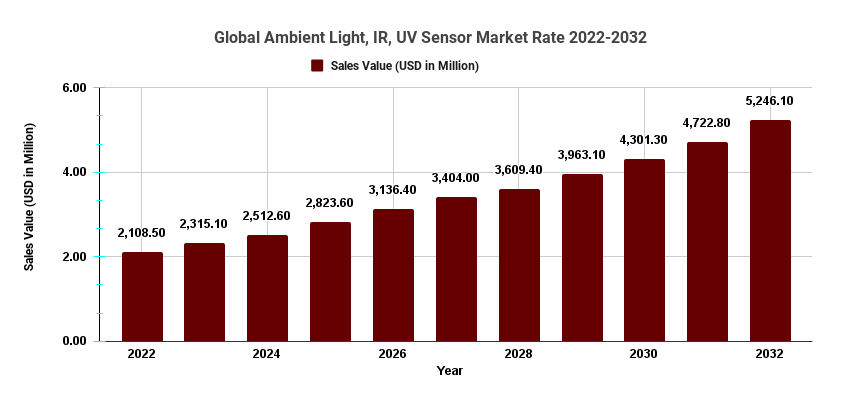Ambient Light, IR, UV Sensor Market Sales to Top US$ 5,760.2 Million by 2033 || CAGR of 9.8%

Page Contents
- Market Overview
- Key Takeaways
- Play a Larger Role in
- Regional Landscape
- Potential Opportunities
- 5 Predictions about the Future
- Some obstacles to the continued growth
- Increasing Demand in Developing Countries
- Drivers
- Restraints
- Opportunities:
- Challenges:
- Market Segmentation
- Top Applications
- Report Scope
- FAQs
- Future Trends
Market Overview
Published Via 11Press : The ambient light, infrared radiation (IRR), and ultraviolet radiation (UV) sensor market refers to an industry involved with producing and selling sensors capable of measuring light from different wavelengths such as visible, infrared radiation (IR), ultraviolet radiation, etc. Such sensors find applications across industries including consumer electronics, automotive, healthcare and industrial – with steadily growing adoption across various applications for these sensors. The ambient light IR& UV sensors market has experienced steady expansion due to this rising popularity in various applications worldwide.
The Ambient Light, IR, and UV Sensor Market size reached US$ 2,108.5 Million in 2022. Looking forward, Market.us expects the market to reach US$ 5,760.2 Million by 2033, exhibiting a CAGR of 9.8% during 2022-2033.
For more insights on the historic period (2017 to 2022), and forecast market size (2023 to 2033) – Request a sample report

Key Takeaways
- The ambient light, infrared (IR), and ultraviolet sensor market is experiencing rapid expansion due to rising demand in sectors like consumer electronics, automotive, and healthcare.
- This market is marked by both established players as well as newcomers entering, creating fierce competition and innovation. Technological innovations, including integration of sensors into smart devices and development of miniaturized sensors are driving market expansion.
- Increased health and safety awareness, the rising trend toward energy-efficient solutions and automation are driving market expansion. The ambient light sensor segment holds the largest market share.
- Asia Pacific region is currently the fastest-growing market for ambient light sensors such as infrared (IR), and ultraviolet radiation (UVR) sensors.
Buy this Complete Business Report – https://market.us/purchase-report/?report_id=60050
Play a Larger Role in
These products play an increasingly crucial role in applications including those listed below:
- Electronic Products: Sensors can be found in electronic products such as smartphones, tablets and laptops to measure ambient light levels as well as UV radiation exposure and radiation levels in general.
- Lighting Systems: Lighting systems use sensors for measuring ambient lighting levels so as to adjust brightness accordingly.
- Others: Sensors have many other uses as well, including healthcare, automotive and industrial settings.
Regional Landscape
The global ambient light, IR, and UV sensor market is segmented into the following regions:
- North America
- Europe
- Asia Pacific
- Latin America
- Middle East & Africa
The Asia Pacific region is the fastest-growing market for ambient light, IR, and UV sensors. The growth of the market in the region is attributed to the rising demand for electronic products, lighting systems, and others.
Potential Opportunities
The following are some of the potential opportunities in the global ambient light, IR, and UV sensor market:
- Increasing demand for sensors in wearable devices
- Growing demand for sensors in automotive and industrial applications
- Rising demand for sensors in healthcare applications
Download PDF Sample with Recent all Updates & Trending Key Players with TOC @ https://market.us/report/ambient-light-ir-uv-sensor-market/request-sample/
Market Demand and Trend
The demand for ambient light, IR, and UV sensors is driven by various factors:
- Consumer Electronics: With so many phones, tablets, smartwatches and wearable devices in use today requiring ambient light sensors in order to optimize screen brightness and power usage, there has been an enormous surge in demand for ambient light sensors to optimize screen brightness and minimize power usage.
- Automotive Industry: Ambient light sensors are widely employed within automotive applications for controlling interior lighting levels and improving driver visibility, as well as for object detection and night vision purposes through advanced driver assistance systems (ADAS). IR sensors also frequently find use.
- Healthcare: UV sensors find widespread application within healthcare for tracing UV radiation exposure, sterilization processes and phototherapy treatments.
- Industrial Sector: IR sensors can be found across many automation and process control applications, from temperature sensing, flame detection and gas analysis to temperature sensing, flame sensing and gas analysis.
Prime Determinants of Growth: Several factors act as prime determinants of growth in the ambient light, IR, and UV sensor market, including:
- Technological Innovations: Innovations in sensor technologies such as miniaturization, improved accuracy and integration with other systems are driving market expansion.
- Consumer Electronics Market Growth: As consumer demand for smartphones, tablets and wearable devices increases exponentially, so too do ambient light sensors – with automotive industries' emphasis on driver assistance systems such as ADAS increasing this need further still. Meanwhile, IR sensors may play a vital role as well.
- Healthcare and Industrial Applications: Ambient light sensors – such as ambient light detectors and infrared (IR)/ultraviolet (UV) detectors – have proven useful tools in both healthcare settings as well as industrial ones, for automation process control, process safety systems and safety system control, leading to tremendous market expansion.
- Government Regulations and Standards: Initiatives designed to encourage energy efficiency and safety within various industries have led to the widespread implementation of ambient light, infrared (IR), and UV sensors in their use.
Factors Affecting the Growth: Several factors can affect the growth of the ambient light, IR, and UV sensor market:
- Intense Competition: The market is highly competitive, with numerous players striving to capture a significant market share. Intense competition can lead to price pressures and impact profit margins.
- Economic Conditions: Economic downturns and fluctuations can influence consumer spending and investment decisions, affecting the demand for ambient light, IR, and UV sensors.
- Supply Chain Disruptions: Disruptions in the supply chain, such as raw material shortages or transportation issues, can impact production and lead to delays in product availability.
- Privacy and Security Concerns: With the increasing use of sensors in various applications, concerns regarding data privacy and security may impact consumer confidence and adoption rates.
5 Predictions about the Future
- Ambient light sensors, infrared (IR), and ultraviolet sensors are expected to experience compound annual compounded annual growth at an anticipated compound annual growth rate of 4.0% during their forecast period.
- Ambient light sensors are projected to continue their dominance in the market.
- Asia Pacific is projected to become one of the fastest-growing markets for ambient light sensors such as IR and UV detecting sensors.
- Ambient light sensors (IR and UV), in particular, will likely benefit from increasing demand across a variety of applications including electronics products and lighting systems.
- Ambient light sensors may experience various challenges within their markets. Such difficulties include high costs of sensors as well as lack of standardization.
Some obstacles to the continued growth
The following are some of the obstacles to the continued growth of the global ambient light, IR, and UV sensor market:
- High cost of sensors
- Lack of standardization
- Competition from substitutes
Increasing Demand in Developing Countries
The demand for ambient light, IR, and UV sensors is increasing in developing countries due to the following factors:
- Rising disposable income
- Growing urbanization
- Increasing awareness about the benefits of sensors
Drivers
- Technological Advancements: Technological advancements such as miniaturization, improved accuracy and integration capabilities of sensors are driving widespread adoption of ambient light sensors (IR and UV) among businesses and consumers.
- Consumer Electronics Market Trends: Smartphones, tablets, wearables and home smart home devices have seen unprecedented popularity; with smartphones alone accounting for 1 billion smartphone sales each month. Their increased use is increasing demand for ambient light sensors while automotive safety initiatives and ADAS systems drive demand for infrared (IR) sensors.
- Awareness about Health and Safety: Increased awareness about UV radiation's harmful effects is driving demand for UV sensors used for healthcare, cosmetics and outdoor applications.
- Energy Efficiency Requirements: Regulations and standards encouraging energy efficiency are driving the use of ambient light sensors in lighting systems to optimize power usage while cutting wasteful consumption of electricity.
- Industrial Automation and Process Control: With increasing adoption of automation and the need for precise monitoring and control in industrial processes comes increased demand for ambient light sensors such as infrared (IR) or ultraviolet radiation sensors in manufacturing or industrial settings.
Restraints
- Cost and Pricing Pressures: Intense competition and price fluctuations can impact sensor manufacturers' profit margins significantly, potentially jeopardizing profit.
- Privacy and Security Concerns: With so many sensors being deployed nowadays, privacy and security issues arise that threaten consumer confidence as well as adoption rates of these technology-driven products.
- Lack of Standardization: An absence of standard protocols and interfaces for sensors may create compatibility issues and hamper their integration seamlessly into various applications.
- Supply Chain Disruptions: Supply chain disruptions caused by raw material shortages or transportation issues can wreak havoc with production, leading to delays in product availability.
Opportunities:
- Emerging Applications: With the increase of IoT devices and connected homes coming online, new opportunities arise for ambient light sensors used for environmental, agriculture and healthcare monitoring as well as UV sensor use in various sectors ranging from healthcare, agriculture and environmental monitoring.
- Integration With Artificial Intelligence and Machine Learning: Integrating ambient light sensors, infrared (IR), ultraviolet (UV), and AI and machine learning technology together to enable advanced applications like smart lighting systems, predictive maintenance programs and autonomous systems is now possible.
- Expanding in Emerging Markets: Emerging economies present sensor manufacturers with great opportunities for expansion in emerging markets and meeting growing consumer electronics and industrial automation demand.
- Cooperations: Collaboration among sensor manufacturers, technology firms and industry stakeholders can encourage innovation while opening up new business opportunities in the ambient light, infrared (IR) and ultraviolet sensor markets.
Challenges:
- Technological Complexity: Engineering accurate and dependable ambient light sensors containing advanced functionalities presents technical hurdles.
- Compliance with Standards: Sensor manufacturers face many regulatory and standard hurdles in fulfilling healthcare and automotive applications, making compliance an immense task.
- Integration Challenges: Integrating sensors into existing systems and verifying compatibility across devices and platforms can be time-consuming and complex, often necessitating costly hardware upgrades or costly third-party integration services.
- Limited Awareness and Education: Lack of understanding regarding the advantages and applications of ambient light sensors such as infrared (IR) and UV detectors may hinder market expansion in developing regions, especially where market entry may otherwise occur.
- Environmental Factors: Sensors may be affected by environmental conditions like extreme temperatures, humidity or other external influences that compromise the performance and lifespan of sensors. This may compromise their performance or lifespan and be detrimental to long-term reliability and usability.
Market Segmentation
Segmentation by Product Type
- Ambient Light Sensors
- IR Sensors
- UV Sensors
Segmentation by End-Use
- Consumer Electronics
- Automotive
- Medical Devices
- Other End-Uses
Top Applications
The key applications of ambient light, IR, and UV sensors include:
- Consumer Electronics (smartphones, tablets, wearables, etc.)
- Automotive (ADAS, interior lighting, etc.)
- Healthcare (UV radiation monitoring, phototherapy, sterilization, etc.)
- Industrial (automation, process control, safety systems, etc.)
- Aerospace and Defense
- Agriculture and Horticulture
- Environmental Monitoring
- Smart Homes and Buildings
- Entertainment and Gaming
- Energy Management
Report Scope
| Report Attribute | Details |
| Market Value (2022) | US$ 2,108.5 Mn |
| Market Size (2032) | US$ 5,760.2 Mn |
| CAGR (from 2023 to 2032) | 9.8% |
| Historic Period | 2016 to 2022 |
| Base Year | 2022 |
| Forecast Year | 2023 to 2032 |
FAQs
Q: What are ambient light sensors used for?
A: Ambient light sensors are used to measure the amount of light in the surrounding environment. They are commonly used in electronic devices to adjust screen brightness, conserve battery power, and improve visibility in different lighting conditions.
Q: How do IR sensors work?
A: IR sensors detect infrared radiation, which is not visible to the human eye. They work by detecting changes in infrared radiation emitted by objects or reflected from surfaces. These sensors are used in various applications such as object detection, proximity sensing, and temperature measurement.
Q: What are UV sensors used for?
A: UV sensors are used to measure the level of ultraviolet radiation in the environment. They find applications in areas such as UV index monitoring, UV exposure measurement for skin safety, sterilization processes, and detection of harmful UV rays in industrial settings.
Q: What factors are driving the growth of the ambient light, IR, and UV sensor market?
A: The growth of the ambient light, IR, and UV sensor market is driven by factors such as increasing adoption in consumer electronics, rising awareness about health and safety, energy efficiency requirements, advancements in sensor technology, and the expansion of industrial automation.
Q: Which regions are witnessing significant growth in the ambient light, IR, and UV sensor market?
A: The Asia-Pacific region, particularly countries like China, Japan, and South Korea, is witnessing significant growth in the ambient light, IR, and UV sensor market. North America is also experiencing rapid growth, driven by its technological advancements and high adoption of consumer electronics.
Q: What are the challenges faced by the ambient light, IR, and UV sensor market?
A: Some challenges faced by the ambient light, IR, and UV sensor market include technological complexity, regulatory compliance, integration issues with existing systems, privacy and security concerns, and environmental factors that can affect sensor performance.
Q: What are the key applications of ambient light, IR, and UV sensors?
A: Ambient light, IR, and UV sensors find applications in various industries. The key applications include consumer electronics (such as smartphones and wearables), automotive (ADAS and interior lighting), healthcare (UV radiation monitoring and sterilization), industrial automation, aerospace and defense, agriculture, environmental monitoring, and energy management.
Q: What are the opportunities for growth in the ambient light, IR, and UV sensor market?
A: Opportunities for growth in the ambient light, IR, and UV sensor market include emerging applications in IoT and smart homes, expansion in the healthcare sector, the automotive industry's demand for ADAS, the industrial automation market, and collaborations and partnerships with technology companies to drive innovation.
Future Trends
The following are some of the future trends in the global ambient light, IR, and UV sensor market:
- Increasing demand for sensors in wearable devices
- Growing demand for sensors in automotive and industrial applications
- Rising demand for sensors in healthcare applications
- Development of new and innovative sensor technologies
- Increasing adoption of smart homes and buildings
Communication Contact:
Global Business Development Team: Market.us
Market.us (Powered By Prudour Pvt. Ltd.)
Send Email: [email protected]
Address: 420 Lexington Avenue, Suite 300 New York City, NY 10170, United States
Tel: +1 718 618 4351
Content has been published via 11press. for more details please contact at [email protected]
The team behind market.us, marketresearch.biz, market.biz and more. Our purpose is to keep our customers ahead of the game with regard to the markets. They may fluctuate up or down, but we will help you to stay ahead of the curve in these market fluctuations. Our consistent growth and ability to deliver in-depth analyses and market insight has engaged genuine market players. They have faith in us to offer the data and information they require to make balanced and decisive marketing decisions.



